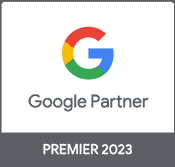Conversion Rate Optimization Case Study: Automotive
Data from our eCommerce conversion rate optimization case study shows that site speed is the most important factor affecting website conversion rate. We believe this case study is the most comprehensive analysis ever done on automotive websites.
Conversion rate optimization case study
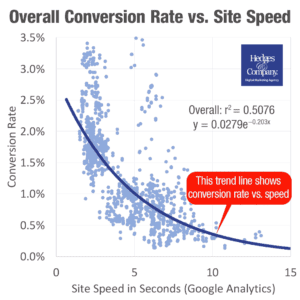
CLICK TO ENLARGE: Millions of transactions over 3-1/2 years shows the impact of site speed (bottom axis) on eCommerce conversion rate (left axis) for automotive parts and accessories websites. The blue line shows typical conversion rates. The R2 value is .5076.
We analyzed millions of website transactions from 2017 through mid-2020, covering three and a half years.
We looked at automotive parts and accessories websites in the US and Canada.
A massive statistical analysis uncovered what websites that converted well had in common. We also looked at websites that didn’t convert well and what they had in common.
Biggest impact on eCommerce conversion rate: site speed
Site speed has the single biggest impact on a website's #conversionrate. #CRO #DrivePartsSales Click To TweetSite speed has the single biggest impact on your website’s conversion rate, according to our statistical analysis. Google and others have been preaching this for years.
Site speed has a good correlation with website conversion rate in our statistical analysis, with an R2 (“R-squared”) value of .5076. In other words, site speed accounts for about 50% of an automotive website’s predicted conversion rate. R-squared is a value from 0% to 100%; 0% is zero correlation and 100% is perfect correlation).
Other factors in our conversion rate optimization case study
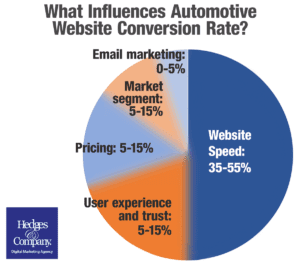
CLICK TO ENLARGE: Our conversion rate optimization case study shows site speed accounts for about half of the conversion rate for automotive parts and accessories websites.
We discovered factors other than site speed that have varying degrees of importance on conversion rate optimization. About 50% on your site’s conversion rate is due to site speed, so here are the factors that account for the other 50%:
Email marketing in our conversion rate optimization case study
One factor in conversion rate optimization that you never hear about: email marketing. Websites with active and well-managed email marketing programs had a higher overall conversion rate. And in Google Analytics, custom segments of users who visit a website from email show those users have a conversion rate two to 10 times higher than average.
Much of website conversion rate is related to user engagement. If you have thousands of your best customers returning to your website regularly, you will have a better conversion rate. Email marketing is also sometimes overdone and not much of a ranking factor, so we gave email marketing 0% to 5% of the total impact to conversion rate.
Your market segment and competitors
Other published conversion rate optimization case studies tend to overlook the market segments a website serves and instead focus on technical matters.
But, if you serve a very competitive market against aggressive rivals, your website conversion rate will be lower. If you sell to a market segment with very little competition, your customers have fewer choices and your website conversion rate will be higher. We gave market segment 5% to 15% of the total impact to conversion rate.
Pricing affects eCommerce conversion rate
Ranking prices as a factor on conversion rate can be tricky in the automotive aftermarket. Some websites sell a lot of products from brands with MAP or unilateral pricing policies. These products are all the same price. Some websites have a lot of private label products without head-to-head comparisons to products on other websites.
In our analysis, some websites clearly had a conversion rate advantage based on pricing, and some did not.
We gave pricing competitiveness 5% to 15% of the total impact to a website’s conversion rate.
User experience and eCommerce conversion rate
User experience (UX), trust signals and product data covers a lot of things. It includes functional things like site navigation or keyword search. It covers product descriptions, like whether information is complete or short, incomplete bullet points. Trust signals like E-A-T are important just like they are with automotive SEO services. For example, whether the company publishes a street address or the name of the founder, or displays badges indicating secure and/or protected transactions, or shows reviews. It can include the look and feel of a website, whether it looks contemporary or it looks outdated. It can even include oversized banners forcing a customer to navigate past them.
Product data is usually “behind the scenes” running a website, but high-quality product data contributes to high-converting websites.
We assigned user experience 5 to 15% of the total impact to a website’s conversion rate.
Mobile site speed vs. conversion rate
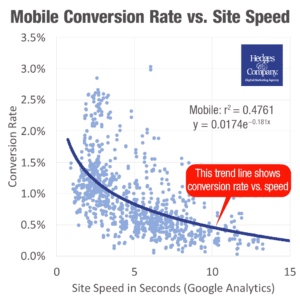
CLICK TO ENLARGE: Millions of transactions over 3-1/2 years shows the impact of mobile site speed (bottom axis) on conversion rate (left axis) for parts and accessories websites. The blue line shows typical mobile conversion rates. The R2 value is .4761.
Mobile-only conversions show slightly different results. Mobile is sometimes overlooked in other conversion rate optimization case studies. Speed is even more important on mobile.
The news that site speed is important isn’t new. As Google put it a couple of years ago: “speed equals revenue.” What is new is that we have quantified it for the first time for aftermarket websites.
According to Google when a mobile page load time goes from 1 second to 3 seconds the probability of a bounce increases 32%. Going from 1 second to 9 seconds increases the probability to 90%.
Mobile shoppers are quick to leave a slow site. They have less patience on a small screen.
Mobile site speed in our conversion rate optimization case study ranked slightly lower than it did for overall conversion rate. We think that’s because on mobile sites the user experience is even more critical.
A fast-loading mobile website with clumsy navigation or too much vertical scrolling will not convert as well.
Site speed: how fast is fast; how to check your website
 Website speed is easily extracted from Google Analytics. There are many tools on the internet to measure your website speed but in our study we found the highest correlation to conversion rate when we pulled site speed from Google Analytics, at the month level.
Website speed is easily extracted from Google Analytics. There are many tools on the internet to measure your website speed but in our study we found the highest correlation to conversion rate when we pulled site speed from Google Analytics, at the month level.
Weekly or daily site speed data had too much variation. Google only pulls sample data to report your site speed. Data at the monthly level pulls in enough data to smooth out inconsistencies and be relevant.
To look at your site speed, follow the steps in the next section to get the correct metrics.
Site speed in Google Analytics
1). Go to Google Analytics, and follow the menu to Behavior >> Site Speed >> Overview.
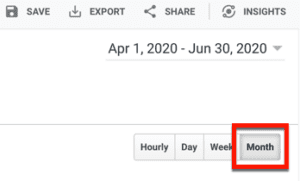 We show this at the right to help you find your way.
We show this at the right to help you find your way.
2). Once you’re on the overview page select “Month” in the upper right corner.
We show how to do this at left.
3). Next, Google Analytics gives you lot of site speed metrics to choose from: “Avg. Page Load Time (sec),” “Avg. Redirection Time (sec),” “Avg. Domain Lookup Time (sec),” “Avg. Server Connection Time (sec),” “Avg. Server Response Time (sec)” and “Avg. Page Download Time (sec).” Select the first one in the left, “Avg. Page Load Time (sec),” which is the default.

If you get lost, just look at this screen shot at right to pick the right one.
The other metrics on site speed look at different sub-components of site speed and just don’t correlate with conversion rate.
To do a quick check on your website’s own conversion rate, refer to this chart.
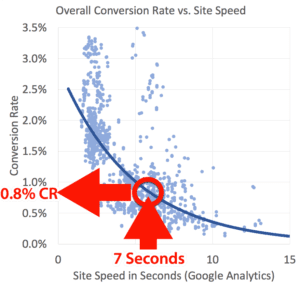 First, look at the bottom axis to find your average website page load time from Google Analytics. Let’s say it is seven seconds.
First, look at the bottom axis to find your average website page load time from Google Analytics. Let’s say it is seven seconds.
Go straight up to the blue trend line. Wherever you land on that trend line, go straight left to the left axis and that should be pretty close to your website’s conversion rate.
In this case, the conversion rate is about 0.8% for a website that loads in about seven seconds.
Refer to the real charts shown above in this article. How does your own website compare to our charted data? Close or way off? Odds are it will be very close.
Average website speed and conversion rates
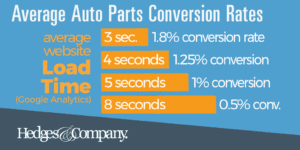
CLICK TO ENLARGE: Average conversion rates for auto parts and accessories websites based on average load time from Google Analytics.
This graphic shows how websites stack up in our conversion rate optimization case study. We condensed a lot of data down to just four averages.
The average conversion rate for a site that loads in 5 seconds is 1%.
If your website loaded in 5 seconds and you improved that to 3 seconds, your conversion rate would nearly double, to 1.8%. Why does that matter?
It matters because without spending any more on marketing you would have an 80% sales increase! Going from a 1% conversion rate to a 1.8% conversion rate is almost doubling your business! It will also make any marketing investment you already have in place more efficient.
Was this helpful vs. other conversion rate optimization case studies?
We hope the conversion rate data presented here is helpful for your automotive parts and accessories website efforts. Let us know in the comments below, or feel free to share on social media! You can also try out our conversion rate optimization tool.
Hey, if you made it down this far, thanks for sticking with us, this article is over 1,600 words!
Common questions on conversion rate optimization
Q: What is a good conversion rate on an auto parts website?
A: A good conversion rate is anything over 1.5%. Some websites will convert at a much higher rate. A conversion rate under 1% makes it more difficult to operate a profitable website.
Q: How to increase conversion rate on an automotive website?
A: One of the most important things you can do to increase conversion rate is to improve your site speed.
Q: What is conversion rate optimization?
A: Conversion rate optimization is the art and science of increasing the percentage of site visitors who perform a transaction on your site either by making a purchase or submitting a lead.
Q: How to use data science to improve conversion rate?
A: You can improve your conversion rate by using data presented in Google Analytics, as well as implementing email marketing best practices, improving shopper engagement and building trust.

